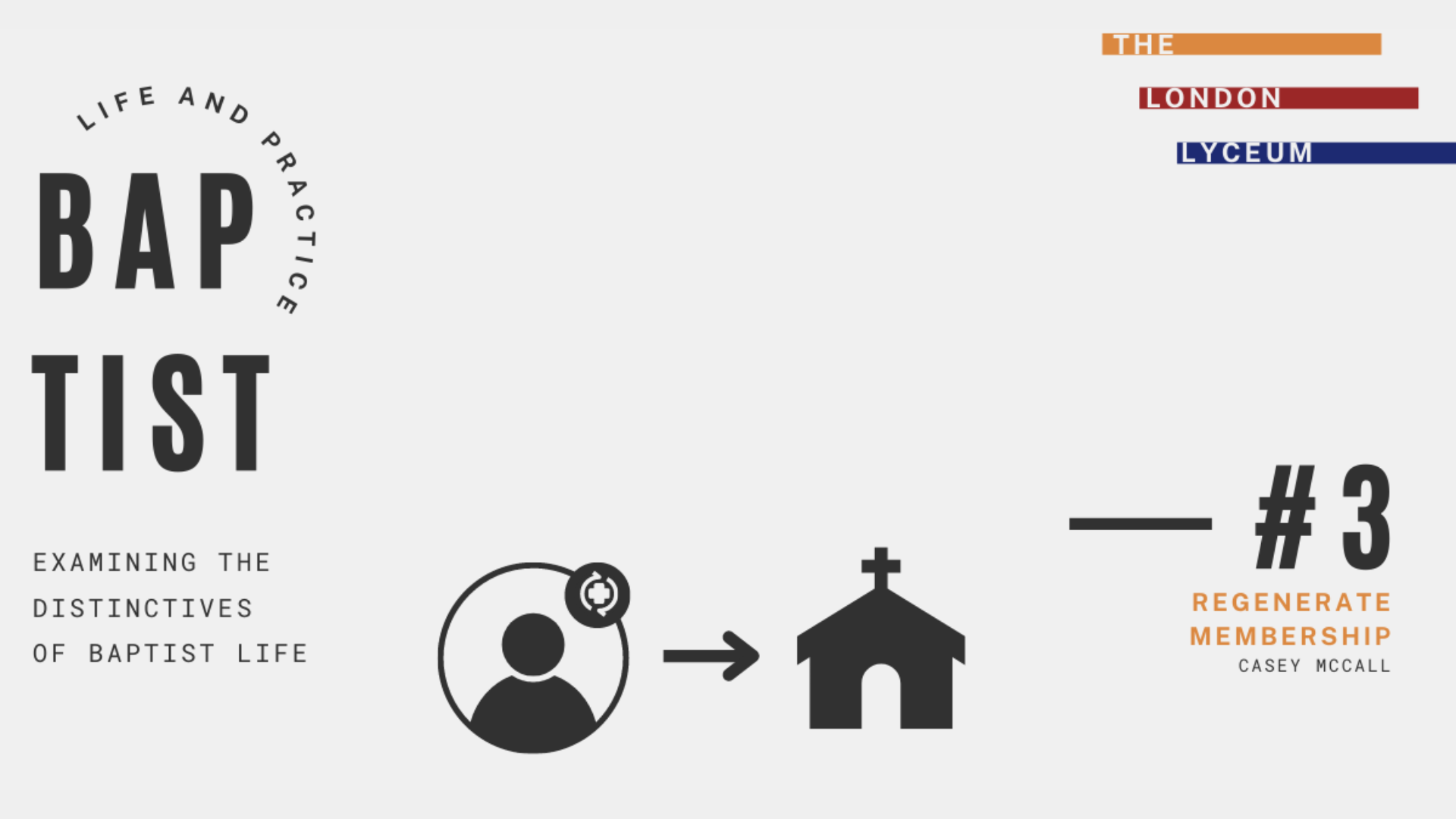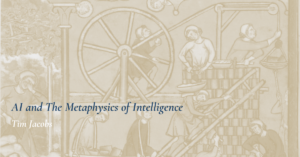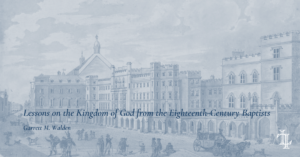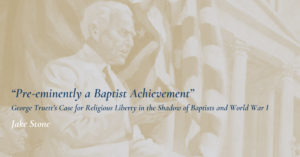Editor’s Note: This is part 3 in our Lyceum Disputation series considering Baptist identity. Stay tuned for further installments. As with all our work, the London Lyceum publishes a range of viewpoints to encourage thinking.
Introduction: A Different Kind of Wall of Separation
Amongst his many other achievements, Thomas Jefferson is known today for his “wall of separation” metaphor describing the relationship between church and state in the American Republic. In a New Year’s Day 1802 letter to the Danbury Baptist Association in Connecticut, the newly inaugurated president penned the words that would shape church-state relations for the next two hundred years and counting. After affirming the long-held Baptist position that “religion is a matter which lies solely between Man and his God,” Jefferson celebrated the non-establishment clause of the First Amendment to the United States Constitution—a revolutionary concession Baptists had worked tirelessly to achieve—before adding that the clause thus built “a wall of separation between Church and State.”
That metaphor does not mean what many today think it means, namely, that it confines religion to private life so that it bears no influence on political machinations. Daniel L. Dreisbach has shown that Jefferson’s note came in the context of other actions wherein the president publicly supported religion, even inviting Baptist John Leland to preach before the House of Representatives two days after writing it. Jefferson was not scolding the persecuted Baptists; he was expressing solidarity with their cause.[1]
No one knows where Jefferson got his metaphor, but he was not the first to use it. In 1644, Roger Williams used it in a published letter to the New England Congregationalist minister, John Cotton—the man who had led the effort to try, convict, and banish Williams from the Massachusetts Bay Colony for his “new and dangerous opinions.” Over a century-and-half before Jefferson, Roger Williams’ advocacy of religious liberty for all had run him afoul of Massachusetts Bay authorities, who were attempting to establish a holy society in the New World in obedience to God’s national covenant with Israel. Williams did not believe that that covenant was still in effect. Consistent with Baptist covenant theology, he believed the coming of Jesus had established a new covenant that redefined the composition of the people of God.
When Roger Williams wrote that God had erected a “hedge or wall of Separation between the Garden of the Church and the Wilderness of the World,” he was not worried about religion’s intrusion into politics; he was concerned about keeping the world—including the state—out of the church.[2] In short, for Williams, the “wall of separation” metaphor described Christ’s efforts to separate his church from the unregenerate world. The church of God under the new covenant, in contrast to national Israel, would be a regenerate people.
Argument
Historically, Baptists have been known for their insistence on baptizing only those who have professed conscious faith in the Lord Jesus Christ. This identification makes sense, for their determined commitment to believer’s baptism isolated them very publicly from virtually every other group of professing Christians, Protestant and Catholic alike. By mandating the baptism of converts, they rejected the validity of infant baptism—a nearly universal practice—and managed to offend even close theological cousins. However, beneath the surface of the baptism waters, the practice that so publicly identified Baptists rested on a fundamental theological commitment to regenerate church membership rooted in covenant theology. Further, it was this dogged commitment to regenerate church membership that led Baptists to advance the cause of religious freedom so tirelessly.
Historical Background: A Peculiar People
In the very first sentence of his book, Baptist Principles Reset, the nineteenth-century Virginia Baptist minister, Jeremiah Bell Jeter, wrote, “A spiritual, or regenerate, church membership…lies at the foundation of all Baptist peculiarities. On this point, Baptists and the few small sects that agree with them differ from the whole Christian world.”[3] Bell’s observation is reinforced by a close reading of Baptist confessions of faith, dating all the way back to the movement’s beginnings. Baptists have not always agreed on everything—not even on issues related to soteriology—but every Baptist in history has agreed that the church should consist of only believers.
John Smyth, who along with Thomas Helwys embraced Baptist principles as exiles in the Netherlands before Helwys returned to establish the first English Baptist church, authored his Short Confession of Faith in Twenty Articles in 1609. Article 12 states, “That the church of Christ is a company of the faithful; baptized after confession of sin and of faith, endowed with the power of Christ.”
In 1644, seven Particular Baptist congregations emerged out of English Puritanism and formulated the London Confession of Faith. This document states, “That Christ hath here on earth a spiritual kingdom which is the Church, which He hath purchased and redeemed to Himself as a peculiar inheritance: which Church, as it is visible to us, is a company of visible saints, called and separated from the world, by the Word and Spirit of God, to the visible profession of the faith of the Gospel, being baptized into that faith and joined to the Lord ad each other by mutual agreement, in the practical enjoyment of the ordinances, commanded by Christ their head and King” (Article 33).
In 1677, the growing movement of Particular Baptists anonymously published a new confession, based largely on the Presbyterian Westminster Confession of Faith (1646), thus showing their theological solidarity with other English Protestants. However, their theological convictions prevented them from replicating the WCF wholesale. After the Act of Toleration was passed by Parliament in 1689, this confession was finalized and published as the 1689 Baptist Confession of Faith (known today as the Second London Confession) and would become the model for American Baptists as well in their slightly amended Philadelphia Confession of Faith (1742). These enormously influential confessions defined the visible church as “all persons throughout the world, professing the faith of the gospel, and obedience unto God by Christ according unto it,” deleting the WCF’s inclusion of “together with their children.” Notably, the Baptist confessions contain fifteen articles on the church, more than doubling the number contained in the WCF. For Baptists, distinguishing the church from the world and defining its nature as comprised exclusively of regenerated members was of paramount importance, for this distinctive separated them from every other Protestant tradition. Thus, they specified that “the Lord Jesus calleth out of the world unto himself, through the ministry of his word, by his Spirit, those that are given unto him by his Father” (2LCF 26:5; PCF 27:5) and that church members “are saints by calling, visibly manifesting and evidencing (in and by their profession and walking) their obedience unto that call of Christ” (2LCF 26:6; PCF 27:6).
More modern Baptist confessions have continued to emphasize regenerate church membership. The New Hampshire Confession (1833) states, “That a visible Church of Christ is a congregation of baptized believers, associated by covenant in the faith and fellowship of the gospel” (Article 11), and the Baptist Faith and Message (2000) defines a church as “an autonomous local congregation of baptized believers, associated by covenant in the faith and fellowship of the gospel” (Article 6).
Historically, to be a Baptist means to affirm regenerate church membership. This belief undergirds the practice of believer’s baptism and has historically distinguished Baptists from all other Christian traditions.
Scriptural Basis: Baptist Covenant Theology
While some have mistakenly characterized Baptists as a “no-creed-but-the-Bible” people, the above examples should delete any such notion. Baptists have historically summarized their doctrinal convictions using creeds, covenants, and confessions. As Andrew Fuller wrote in response to those in his own day who argued that creeds were inconsistent with Christian liberty and the rights of conscience, “The man who has no creed has no belief.” He concluded that essay with these words: “If the articles of faith be opposed to the authority of Scripture, or substituted in the place of such authority, they become objectionable and injurious; but if they simply express the united judgment of those who voluntarily subscribe to them, they are incapable of any such kind of imputation.”[4] According to Fuller, a confession is valid to the degree that it accurately expresses the teaching of Scripture as understood by the people confessing it. So, where in Scripture do Baptists derive their distinctive belief in regenerate church membership?
Baptist theologian John S. Hammett writes, “The biblical basis for seeing the church as composed exclusively of believers is so strong and obvious that the difficulty is in seeing how this idea was ever obscured.”[5] The case for regenerate church membership, in fact, is so evident that it’s difficult to decide where to begin making the argument. One approach involves the presentation of proof texts. Ephesians 5:27, as just one example of many, emphasizes Jesus’ goal of bringing his church to complete sanctification, a privilege reserved only for those regenerated by the Spirit. Others make the argument logically as a corollary of the Bible’s clear teaching on church discipline, for that process seems designed to root out unregenerate members who have been admitted mistakenly. While these approaches are helpful, Baptists have historically rooted their doctrine of regenerate church membership in robust covenant theology. In other words, the Baptist conviction that Christ’s church should be composed of only believers is rooted in their distinct understanding of the relationship between biblical covenants.[6]
The essence of Baptist covenant theology can be boiled down to one scriptural principle, summarized well by seventeenth-century Particular Baptist, Nehemiah Coxe: “the old covenant and the new differ in substance and not only in the manner of their administration.”[7]
Paedobaptist theologians, then and now, describe the old and new covenants as two separate administrations of the same covenant of grace. Thus, God made a covenant of works before the fall that was broken by human sin and a covenant of grace after the fall that was manifested in separate administrations, one under the old covenant through Abraham, Moses, and David and one under the new covenant through Christ. Paedobaptist covenant theology emphasizes continuity between the old and new covenants, since both are administrations of God’s covenant of grace. In the words of Pascal Denault, “This conception had a significant and definitive impact on Reformed ecclesiology because, by considering that the church was under the same covenant as Abraham’s descendants, the Old Testament Scriptures became normative in defining the doctrine of the church and its link to the covenant of grace.”[8] If the old and new covenants are both administrations of God’s singular covenant of grace, then the church should look to Israel as the model for God’s people. Just as Israel was comprised of both regenerate and unregenerate members who all received God’s covenant sign of circumcision, so should the church be of mixed constitution under the new sign of baptism.
Baptist theology has long refuted this claim of one covenant in two administrations, instead arguing that the old and new covenants are two distinct covenants. Baptists disagree among themselves on the precise relationship of the Old Testament covenants to one another and on the degree to which instruction given under those covenants is binding, but all Baptist covenant theology sees those covenants as pointing forward typologically to God’s final covenant in Christ. In other words, Baptists believe that the new covenant, prophesied in Jeremiah 31:31–34, is actually new. Baptists, therefore, have emphasized discontinuity between covenants, since Jeremiah 31 points out three ways that the new covenant would be unlike the old. First, God would regenerate his people by writing his law on their hearts. Ezekiel 36:26–27 points to the same promise, “And I will give you a new heart, and a new spirit I will put within you. And I will remove the heart of stone from your flesh and give you a heart of flesh. And I will put my Spirit within you, and cause you to walk in my statutes and be careful to obey my rules.” Second, Jeremiah prophesied that God’s people under the new covenant would all know God. Finally, members of this covenant would have their sins completely forgiven.
The New Testament explicitly links these promises to the work of Christ. The cup of the Lord’s Supper is “the new covenant in [Christ’s] blood” (Luke 22:20; cf. 1 Cor 11:25). The apostles are ministers of a new covenant in the Spirit as opposed to the old covenant in the law (2 Cor 3:6). In the new covenant, Christ mediates a better covenant enacted on better promises (Heb 8:6) and makes the first covenant obsolete (Heb 8:13). These covenant promises, Baptists argue, are for all of God’s people. In Christ, God has fulfilled all his previous covenants. In contrast to the old covenant, every single member of God’s new covenant is regenerate. No one is born into this covenant, for entrance depends on sinners responding in faith and repentance to the preached gospel. The church, therefore, is exclusively comprised of regenerate and baptized believers.
Implication: Religious Liberty
Baptist insistence on regenerate church membership may, at first glance, seem to be of limited consequence to Baptist political theology, but there is a reason the doctrine has persisted alongside advocacy of religious liberty throughout Baptist history. By insisting that church members possess conscious faith in Christ, Baptists have opposed every form of external coercion. If parents are not authorized to violate the consciences of their own children under the new covenant by administering baptism, much less can government overrule the consciences of citizens by enforcing worship of God. As the Baptist Faith and Message (2000) so clearly states, “God alone is Lord of the conscience…The church should not resort to the civil power to carry on its work. The gospel of Christ contemplates spiritual means alone for the pursuit of its ends” (Article 17). In denying any governmental role in pursuit of Christ’s mission, Baptist churches preserve the integrity of the new covenant. Only Christ can bring about true and lasting spiritual change. The sword of the Spirit, not the sword of the magistrate, must be used to convince stubborn consciences. Christ has not handed the keys of his kingdom to the state; he’s entrusted that job exclusively to his church (Matt 16:17–19; 18:15–20).
Recently, Graham Shearer has argued that Baptist identity does not require separation of church and state, and some have adopted the label “magisterial Baptist.”[9] To clarify what is meant by “magisterial,” Alister McGrath’s brief description is helpful: “Whereas the radical reformers regarded such authorities as having no rights or authority within the church, the mainstream reformers argued that the church was, at least to some extent, subject to the secular agencies of government. The magistrate had a right to some degree of authority within the church, just as the church could rely on the authority of the magistrate to enforce discipline, suppress heresy, or maintain order.”[10]
Shearer bases his argument on Matthew Bingham’s thesis that the label “Baptist” is anachronistic when applied to seventeenth century Particular Baptists who saw themselves within the wider Reformed Puritan movement as Congregationalists who restricted baptism to believers only.[11] These baptistic Congregationalists, Bingham shows, participated in Cromwell’s government, which granted toleration to certain Protestant sects that met the government’s theological tests. Shearer believes this brief historical episode (Cromwell’s Protectorate only lasted five years) opens the door for Baptists to embrace political theologies that view the state as a partner for the church in the shared goal of forming “an explicitly Christian, even Reformed, state.”
Bingham’s thesis is well-researched, but Shearer’s conclusions simply do not follow. One politically exceptional five-year period does not undo the entire theological tapestry of Baptist history. Further, Shearer presents a bit of a straw man when he suggests that his argument proves “Baptists from the beginning have had an interest in the political and constitutional life of the nation and its religious implications.” Few would deny the historical interest of Baptists in politics and the welfare of the state, but that interest is grounded in texts that call Christians to seek the general good of the society in which they live (Jer 29:7; Gal 6:10).
Baptists, however, have consistently denied the right of the state to intrude on the sacred affairs of Christ’s regenerate people. The wall of separation does not keep Christ’s people out of the affairs of state; it keeps the state out of the affairs of the church. Baptists do not ask the state for help in church affairs because they have historically trusted the higher power of word and Spirit to regenerate hearts. Why would we settle for magisterial edict when we have the one who makes “light shine out of darkness” (2 Cor 4:6)?
Baptists affirm regenerate church membership because we believe each person is personally accountable to God, and therefore, faith cannot be coerced. Religious liberty is simply the application of this core theological tenet to political theology. Baptists, by definition, believe that the coming of Christ marks a new covenant arrangement that necessitates internal regeneration of the heart as the basis for joining God’s covenant people. Under the new covenant, external political coercion is not only useless, but violates the very nature of the covenant.
Conclusion
Affirming regenerate church membership doctrinally means nothing if Baptist churches fail to practice it. While this essay has focused on Baptist history to show the historical importance of this doctrine with some implications for political theology, much more could be written about the failure of contemporary Baptists to practice regenerate church membership in the name of pragmatism. A theoretical theological commitment is useless if Baptist churches admit unregenerate church members and fail to call straying members to repentance and restoration. While no course of action will ever guarantee a completely regenerate visible church, the call of Christ demands that our churches use the keys to “bind” and “loose” with wisdom, truth, and grace.
[1] Daniel L. Dreisbach, Thomas Jefferson and the Wall of Separation Between Church and State (New York and London: New York University Press, 2002), 23.
[2] James Calvin Davis, ed., On Religious Liberty: Selections from the Works of Roger Williams (Cambridge and London: The Belknap Press of Harvard University Press, 2008), 70.
[3] Jeremiah B. Jeter, Baptist Principles Reset (Richmond: The Religious Herald Co., 1902), 23.
[4] Andrew Fuller, “Creeds and Subscriptions,” in The Complete Works of the Rev. Andrew Fuller, vol. 3 (Harrisonburg: Sprinkle Publications, 1988), 449–451.
[5] John S. Hammond, Biblical Foundations for Baptist Churches: A Contemporary Ecclesiology (Grand Rapids: Kregel, 2005), 83.
[6] I offer here an abbreviated version of the argument. For much more detailed presentations of various Baptist approaches to the covenants, see Stephen J. Wellum, “Baptism and the Relationship Between the Covenants,” in Believer’s Baptism: Sign of the New Covenant in Christ, ed. Thomas R. Schreiner and Shawn D. Wright, NAC Studies in Bible & Theology (Nashville: B & H Academic, 2006), 97–161; Samuel D. Renihan, From Shadow to Substance: The Federal Theology of the English Particular Baptists (1642–1704) (Oxford: Regent’s Park College, 2018); Pascal Denault, The Distinctiveness of Baptist Covenant Theology: A Comparison Between Seventeenth-Century Particular Baptist and Paedobaptist Federalism, Rev. Ed. (Birmingham: Solid Ground Christian Books, 2013); Nehemiah Coxe and John Owen, Covenant Theology from Adam to Christ (Palmsdale: Reformed Baptist Academic Press, 2005); Fred Malone, The Baptism of Disciples Alone: A Covenantal Argument for Credobaptism Versus Paedobaptim (Cape Coral: Founders Press, 2003); Jeffrey D. Johnson, The Kingdom of God: A Baptist Expression of Covenant & Biblical Theology (Conway: Free Grace Press, 2014); Peter J. Gentry and Stephen J. Wellum, Kingdom Through Covenant: A Biblical-Theological Understanding of the Covenants (Wheaton: Crossway, 2012); Thomas R. Schreiner, Covenant and God’s Purpose for the World (Wheaton: Crossway, 2017).
[7] Coxe and Owen, Covenant Theology, 30.
[8] Denault, Distinctiveness of Baptist Covenant Theology, 37.
[9] Graham Shearer, “Must Baptists Reject A Christian State?” Ad Fontes, accessed July 15, 2022, https://adfontesjournal.com/church-history/must-baptists-reject-a-christian-state-2/. Joe Rigney defines a “magisterial Baptist” as “someone who accepts Protestant political philosophy (magisterial two-kingdoms: Calvin, Hooker, Althusius) but embraces credo-baptism” (Twitter).
[10] Alister McGrath, Reformation Thought: An Introduction (Hoboken and West Sussex: Wiley Blackwell, 2021), 3.
[11] Matthew Bingham, Orthodox Radicals: Baptist Identity in the English Revolution (Oxford: Oxford University Press, 2019).
Author
-

Casey McCall is Lead Pastor at Ashland Community Church in LaGrange, Kentucky. He is married to Niki, and they have five children. He attended Samford University and received his Master of Divinity from The Southern Baptist Theological Seminary where he is currently pursuing PhD studies in Church History.
View all posts



